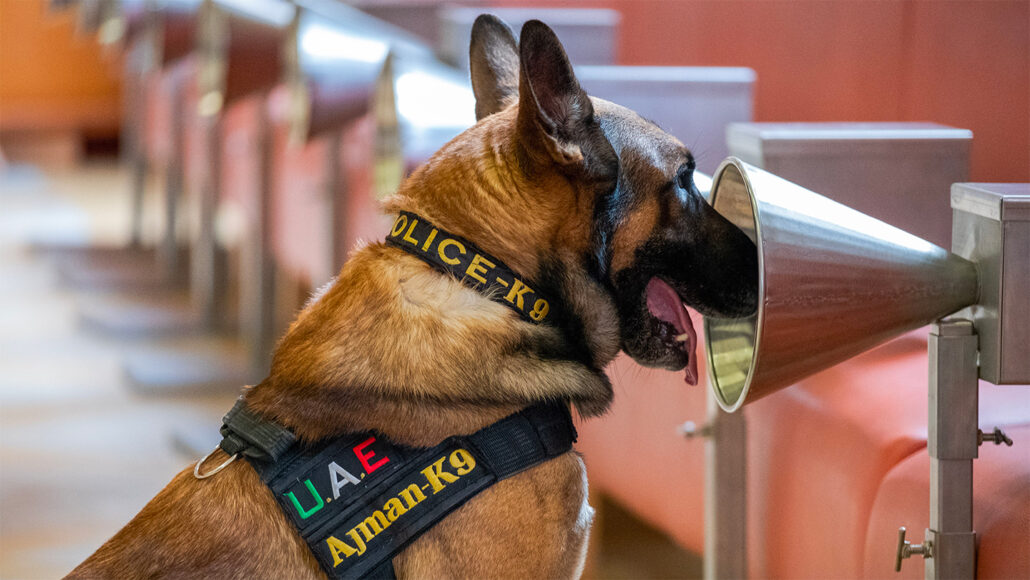To test for COVID-19, a dog’s nose can match a nose swab
Trained canines are even better than lab tests at picking out cases having no symptoms

Dogs have been trained to sniff out cases of COVID-19. This canine in the United Arab Emirates takes a whiff of a sample through a special cone. These dogs are as reliable as lab tests, a new study suggests.
Nosaïs Team (CC BY 4.0)
Two years ago, several groups of scientists showed dogs could reliably identify the scent of people who had COVID-19. Now one of those groups has gone on to show that dogs are every bit as reliable as lab tests at detecting cases of COVID-19. And they’re even better than PCR tests for identifying infected people who don’t have symptoms. A big bonus: The canines are less invasive than a swab up the nose. And much cuter.
The new study trained dogs to smell sweat samples from 335 people. These canines sniffed out 97 percent of the cases that were found to be COVID-positive in PCR tests. And they found all 31 COVID-19 cases among 192 of the infected people who had no symptoms. Researchers shared their findings June 1 in PLOS One.
PCR tests can sometimes go wrong. But “the dog doesn’t lie,” says Dominique Grandjean. He’s a veterinarian at the National School of Veterinary Medicine of Alfort in Maisons-Alfort, France. He also led the new study and a smaller, pilot study back in 2020.
In the latest study, the dogs sometimes mistook another respiratory virus for the coronavirus, Grandjean and his colleagues found. But overall, the canine noses picked up more COVID-19 cases than did antigen tests, like most at-home tests. And some evidence, he says, suggests the dogs can pick up symptom-free infections up to 48 hours before people test positive by PCR.
Dogs could help screen crowds at places such as airports, schools or concerts, says Grandjean. And the animals may provide friendly alternatives for testing people who balk at nasal swabs.
Sniff tests
The study included dogs from French fire stations and from the Ministry of the Interior of the United Arab Emirates on the Persian Gulf. The researchers trained the animals to detect coronavirus by rewarding them with toys — usually tennis balls. “It’s playtime for them,” Grandjean says. It takes about three to six weeks to train a dog to pick out COVID-19 cases from sweat samples. How long it takes depends on the dog’s experience at detecting scents.
The dogs then sniffed cones housing samples of sweat that had been collected from the underarms of volunteers. Sweat swabbed off the back of people’s necks worked, too. Even a whiff of used face masks worked well, Grandjean says.
These results show that odors from any of multiple sites on the body can be used for canine screening, says Kenneth Furton. He is a forensic chemist at Florida International University in Miami.
Although Furton did not take part in the new study, he has tested dogs at detecting COVID-19. The new results are similar to previous, smaller studies, he notes. Both show that dogs perform as well as or even better than PCR tests for detecting SARS-CoV-2. That’s the virus that causes COVID-19. He and his team have used dogs at schools and a music festival. They even did a small trial to screen airline employees for COVID-19.
One big advantage of dogs over other tests is their speed, Furton says. “Even with what we call a rapid test, you’re still going to have to wait tens of minutes or even hours,” he notes. The dog can make a judgment call “in a matter of seconds or even fractions of seconds,” he notes.
It’s not clear exactly what dogs are smelling when they detect COVID-19 or other diseases, says Cynthia Otto. A veterinarian, she works at the University of Pennsylvania School of Veterinary Medicine in Philadelphia. There she directs the school’s working dog center. What the dogs pick up on may not be a single chemical, she says. Instead, it could be a pattern of changes. For example, they may detect more of certain aromas and less of others. “It’s not like you could create an odor perfume bottle that would be the scent of COVID,” she suspects.
To date, some doctors, scientists and government officials have been skeptical of the claims that dogs can sniff out COVID, Grandjean says. He finds this reluctance puzzling. Governments already use dogs to sniff out drugs and explosives. Some are being tested for detecting other diseases, such as cancer, he says. “Every time you take a plane, it’s because dogs have been sniffing your luggage [and found] no explosives. So you trust them when you take a plane,” he says, “but you don’t want to trust them for COVID?”
People may not think of dogs as high-tech the way electronic sensors are. “But dogs are one of the highest-tech devices we have,” Furton says. “They’re just biological sensors, instead of electronic sensors.”
One of the bigger drawbacks for dogs is that they take time to train. Right now, there aren’t even enough dogs trained to detect explosives, let alone diseases, Otto says. Not just any dog will do. “Dogs that work well in that lab setting may not work well in a people setting,” she adds. Handlers can also influence the dog’s response and must be able to read the dog well, she says. “We need more good dogs.”







